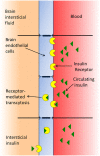Insulin in the brain: its pathophysiological implications for States related with central insulin resistance, type 2 diabetes and Alzheimer's disease
- PMID: 25346723
- PMCID: PMC4191295
- DOI: 10.3389/fendo.2014.00161
Insulin in the brain: its pathophysiological implications for States related with central insulin resistance, type 2 diabetes and Alzheimer's disease
Abstract
Although the brain has been considered an insulin-insensitive organ, recent reports on the location of insulin and its receptors in the brain have introduced new ways of considering this hormone responsible for several functions. The origin of insulin in the brain has been explained from peripheral or central sources, or both. Regardless of whether insulin is of peripheral origin or produced in the brain, this hormone may act through its own receptors present in the brain. The molecular events through which insulin functions in the brain are the same as those operating in the periphery. However, certain insulin actions are different in the central nervous system, such as hormone-induced glucose uptake due to a low insulin-sensitive GLUT-4 activity, and because of the predominant presence of GLUT-1 and GLUT-3. In addition, insulin in the brain contributes to the control of nutrient homeostasis, reproduction, cognition, and memory, as well as to neurotrophic, neuromodulatory, and neuroprotective effects. Alterations of these functional activities may contribute to the manifestation of several clinical entities, such as central insulin resistance, type 2 diabetes mellitus (T2DM), and Alzheimer's disease (AD). A close association between T2DM and AD has been reported, to the extent that AD is twice more frequent in diabetic patients, and some authors have proposed the name "type 3 diabetes" for this association. There are links between AD and T2DM through mitochondrial alterations and oxidative stress, altered energy and glucose metabolism, cholesterol modifications, dysfunctional protein O-GlcNAcylation, formation of amyloid plaques, altered Aβ metabolism, and tau hyperphosphorylation. Advances in the knowledge of preclinical AD and T2DM may be a major stimulus for the development of treatment for preventing the pathogenic events of these disorders, mainly those focused on reducing brain insulin resistance, which is seems to be a common ground for both pathological entities.
Keywords: Alzheimer’s disease; biological actions; brain; central insulin resistance; insulin; pathophysiological implications; receptors; type 2 diabetes.
Figures



References
Publication types
LinkOut - more resources
Full Text Sources
Other Literature Sources
Miscellaneous

